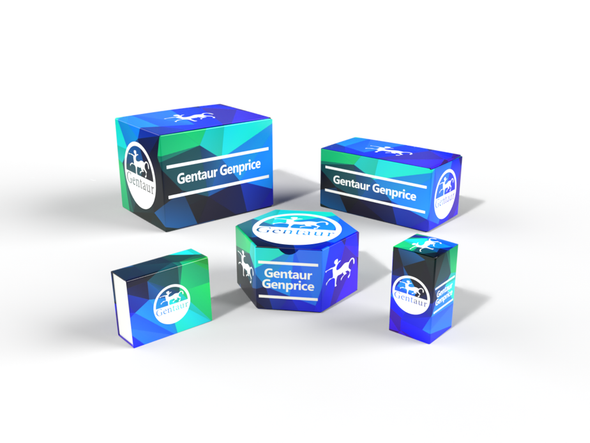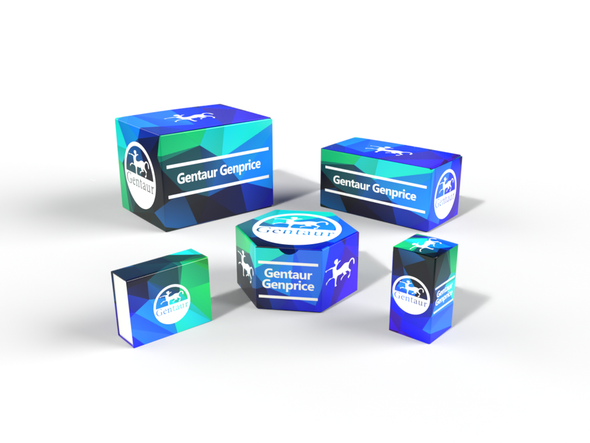Description
Mouse Anti-OVA IgE Antibody Assay Kit - Cat Number: 3004 From .
Research Field: Allergic Asthma, Food Allergy
Clonality: N/A
Cross-Reactivity:
Host Origin: N/A
Applications: N/A
Isotype: N/A
Detection Range: 50 ng/ml-0.78 ng/ml
Sample Type: Serum, Plasma, Culture Media
Concentration: N/A
Immunogen:
DESCRIPTION: ELISA kit to quantify mouse non-serum anti-ovalbumin IgE antibodies
FORMAT: 96-well ELISA Plate with removeable strips
ASSAY TYPE: Indirect ELISA
ASSAY TIME: 4.5 hours
STANDARD RANGE: 50 - 0.8 ng/ml
NUMBER OF SAMPLES: Up to 40 (duplicate) samples/plate
SAMPLE TYPES: Culture Media & Purified IgE
RECOMMENDED SAMPLE DILUTIONS: 1:10 (at least)
CHROMOGEN: TMB (read at 450 nm)
STORAGE: -20°C for 12 months
VALIDATION DATA: Intra-Assay (1.6-1.9%) /Inter-Assay (1.7-2.6%) /Spiking Test (89-98%)
NOTES: This kit cannot be used to assay mouse anti-OVA IgE antibodies in serum
INTRODUCTION
In order to study the pathogenesis of allergic diseases, mice are the most practical experimental animals, due to the variety of inbred strains and transgenic and gene knockout mice that are available. Serum IgE levels are often raised in allergic diseases and parasitic infections, although serum IgE level alone does not reflect the allergic state and the clinical symptoms of the patient. However, it is apparent that a raised serum IgE level aids in the diagnosis of these diseases in humans. As ovalbumin (OVA) is one of the most widely used antigens for studying allergic diseases in mice (4-7), , Inc. provides ELISA kits to determine OVA-specific mouse subtype antibodies and to determine mouse total serum antibody levels. For more information, please visit www..com.
The Mouse Anti-OVA IgE Antibody ELISA Kit (Catalog # 3004) is designed to detect anti-OVA IgE antibodies in limited samples such as hybridoma cell culture supernatant and solutions containing anti-OVA IgE antibodies without other subclasses of anti-OVA antibodies present. The secondary antibody used in this kit reacts equally with both IgEa (Balb/c) and IgEb (C57BL/6) allotypes, so it is not necessary to run two separate assays using two independent IgEa and IgEb standards. It does not
cross-react with any other mouse immunoglobulin subclasses or subtypes (IgA, IgM, IgG, IgG1, IgG2a, IgG2b, IgG2c, or IgG3). Note: This kit is an indirect ELISA using an OVA-coated plate to detect IgE; this kit cannot assay anti-OVA IgE antibodies in mouse serum.The competitive binding of other antibody subclasses recognizing the same antigenic epitopes on OVA may reduce anti-OVA IgE binding to the OVA, as serum IgE levels are usually 1/1000 lower than that of IgG. For assaying anti-OVA IgE antibodies in mouse serum, please use the Mouse Serum Anti-OVA IgE Antibody Detection ELISA Kit (Catalog # 3010). Please contact us at support@.com for moreinformation
KIT COMPONENTS
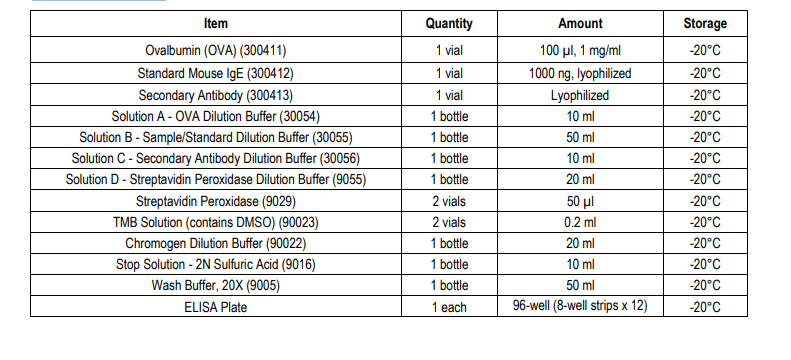
ASSAY OUTLINE

PLATE MAPPING
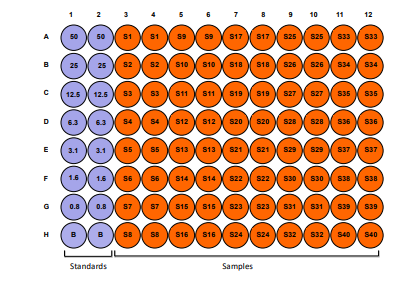
NOTES BEFORE USING ASSAY
NOTE 1: It is recommended that the standard and samples be run in duplicate.
NOTE 2: Warm up all buffers to room temperature before use.
NOTE 3: Crystals may form in Wash Buffer, 20X when stored at cold temperatures. If crystals have formed, warm the wash buffer by placing the bottle in warm water until crystals are completely dissolved.
NOTE 4: Measure exact volume of buffers using a serological pipet, as extra buffer is provided.
NOTE 5: Cover the plate with plastic wrap or a plate sealer after each step to prevent evaporation from the outside wells of the plate.
NOTE 6: For partial reagent use, please see the assay protocol’s corresponding step for the appropriate dilution ratio. For example, if the protocol dilutes 50 µl of a stock solution in 10 ml of buffer for 12 strips, then for 6 strips, dilute 25 µl of the stock solution in 5 ml of buffer. Partially used stock reagents may be kept in their original vials and stored at -20⁰C for use in a future assay.
NOTE 7: This kit contains animal components from non-infectious animals and should be treated as potential biohazards in use and for disposal.
NOTE 8: Serum IgE antibodies are a mixture of multiple antibodies with a wide range of affinity. For example, the affinity of individual monoclonal antibodies to the antigen varies significantly among clones and differs by tens to hundreds of times. The OD value obtained in ELISA in an antibody assay depends on the concentration of the antibody as well as the affinity of the antibody to the antigen. In general, ELISA data using a monoclonal antibody as a standard does not reflect the absolute levels of IgE. Therefore, IgE levels determined by this kit should be expressed as ng of IgE equivalent to the standard per ml.
ASSAY PROCEDURE
Add OVA Solution: Dilute one vial of Ovalbumin (OVA) with 10 ml of OVA Dilution Buffer. Alternatively, dilute according to the table below. Add 100 µl of OVA solution to each well and incubate at 4°C overnight. Any leftover OVA Stock Solution may be stored at -20°C for future assays.
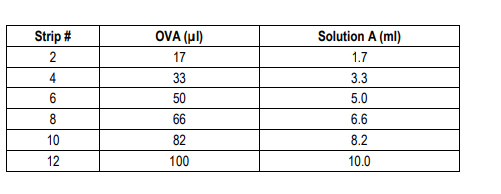
Prepare Standard Dilutions: The recommended standard range is 0.8-50 ng/ml. Dissolve one vial of Standard in 1 ml of
Sample/Standard Dilution Buffer (Solution B) and keep it as a 1000 ng/ml standard stock. Take 50 µl of the standard solution (1000 ng/ml) and add it to 950 µl of Solution B to make a 50 ng/ml IgE standard solution.
Then serially dilute it with Solution B. For example, mix 250 µl of the stock solution with an equal volume of Solution B to make a 25 ng/ml stock solution, and then repeat it five more times for 12.5, 6.3, 3.1, 1.6, 0.8 ng/ml standard solutions. The remaining 1000 ng/ml standard stock solution can be stored at -20⁰C for use in a future assay. , Inc. recommend making fresh serial dilutions for each assay.


